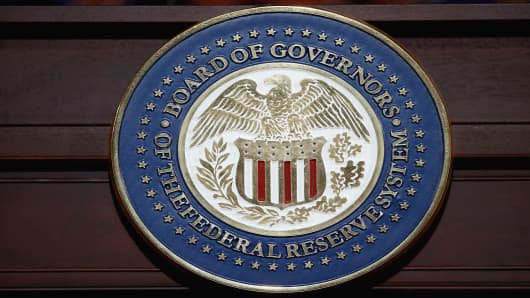With the economy weakening and fears growing of a double-dip recession, officials at the Federal Reserve seem to be split over how the central bank could or should respond.
In an interview Wednesdayon CNBC, Dallas Fed President Richard Fisher declared unambiguously: “I think we’ve done enough.”
He pointed out that the Fed has injected some $1.4 trillion into the banking system, that banks hold some $1 trillion of excess reserves, and that nonfinancial corporations hold around $1.5 trillion of cash on their books.
But St. Louis Fed President James Bullard, in an interview with the Washington Post, suggested that if the economy weakens, the Fed should step in again.
"If the economic situation changes, policy should react," he said. "You shouldn't sit on your hands...I think there's plenty more we could do if we had to."
There are several questions at play here. First, should the Fed step in? Second, if so, what tools are available? And third, would they have any effect?
Among the potential responses in the face of another economic downturn, the Fed could go out and buy more paper, injecting additional cash into the economy.
The trouble, as Fisher has pointed out, is that there’s a ton of cash out there and, he believes, it’s political and uncertainty that keeps it from being deployed. Muni bonds would be ripe for Fed purchases if the Fed wanted to get into the business of picking winners and losers among local and state governments.
The Fed could also lower the interest rate it pays on excess reserves from 25 basis points to zero to give a further incentive to the banks to put that cash to work, thought it’s hard to imagine that 25 basis points would have much effect.
(Several months ago at a conference, a British central banker actually suggested negative interest rates on excess reserves, that is, charging banks a fee to keep excess reserves on deposit at the Fed.)
Finally, the Fed could hyper-extend the commitment to keep interest rates exceptionally low for an extended period, somehow making it clear to investors that it won’t change rates for a number of years. The problem is that central bankers hate pre-committing policy to definitive dates, feeling it ties their hands if the economy changes.
Most interesting of all the comments are those by Fed Governor Kevin Warsh. In a speech that didn’t get as much play as it should have, he outlined a fairly strict test for any further action by the Fed.
“In my view, any judgment to expand the balance sheet further should be subject to strict scrutiny,” Warsh said in Georgia at the end of June. “I would want to be convinced that the incremental macroeconomic benefits outweighed any costs owing to erosion of market functioning, perceptions of monetizing indebtedness, crowding-out of private buyers, or loss of central bank credibility. The Fed's institutional credibility is its most valuable asset.”
The statement rings of skepticism that any good could come from further quantitative easing and sets a high bar for more action.
During the crisis,Warsh was a top lieutenant of Fed Chairman Ben Bernanke. But it’s unclear now if he’s speaking the chairman’s or his own book. It may be, now that the crisis has subsided, Warsh feels more free to speak his own, more conservative, mind about issues of Fed intervention.
Or Warsh could be doing what he’s done in the recent past: acting as an advance guard for the chairman’s own thinking. For his part, Bernanke has been neutral on the issue.
Testifying before Congress shortly after the Fed opened up international swap lines to combat the festering European crisis, Bernanke said: “Our ongoing international cooperation sends an important signal to global financial markets that we will take the actions necessary to ensure stability and continued economic recovery.”
Watch the Fed's Actions More Than Words
Indeed, regardless of what any Fed official says, it’s always better to look at the Fed’s actions rather than its words (and to listen to the chairman’s words before all others.)
The Fed blinked for about a nanosecond amid worries about spreading European financial contagion to reopen those swap lines that allowed the foreign central banks to borrow dollars from the Fed. In the face of a renewed liquidity crunch here in the U.S., the Fed could rather quickly open up the facilities it used during the crisis to reliquify the system.
Warsh points out one danger: that the Fed would lose credibility if it stepped in and had little effect. But there’s a danger on the other side: that the Fed could be perceived as having no tools to combat further weakness. That’s an invitation for the shorts to test the Fed’s mettle.
To delve even further into the nuance of Fed policy, much of this boils down to communication strategy. The Fed needs to clearly explain to markets what it could do if the economy weakens further and why it would work. But it needs to be vague enough to avoid spooking markets into thinking that it's panicked about the economic outlook.
Despite their differences, most Fed officials are sticking to their forecast of growthof around 2 percent to 3 percent for the rest of the year. Even the low end of that range is unlikely to be enough to restart the printing presses.
It's around 1 percent (think of the stall speed of an aircraft), where serious questions will be raised about whether the economy is entering double-dip territory and whether the Fed will need to recalibrate policy.



